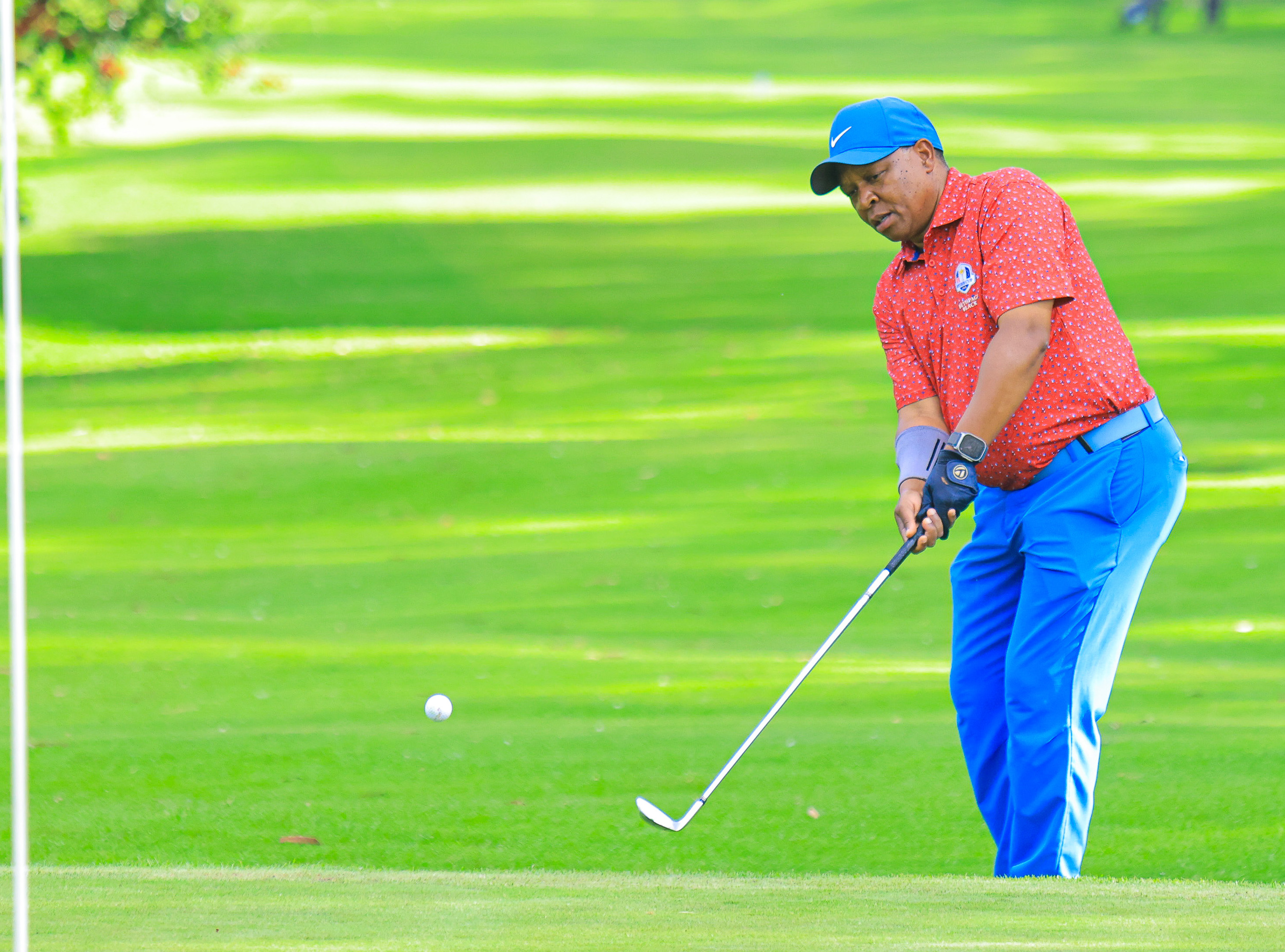 Greg Snow tees off during the second round of the Betika Masters, the eighth leg of the Sunshine Development Tour East Africa Swing at Limuru Country Club/ HANDOUT
Greg Snow tees off during the second round of the Betika Masters, the eighth leg of the Sunshine Development Tour East Africa Swing at Limuru Country Club/ HANDOUTWhen the final putt dropped at the Limuru Country Club on Tuesday, Greg Snow raised his fist in quiet triumph.
The Muthaiga Golf Club pro had just clinched the Betika Masters, his first title on the Sunshine Development Tour — East Africa Swing, after three gruelling days of rain, wind and fierce competition.
It was a defining win for Snow, but an even bigger moment for East African golf. The Limuru event marked the eighth leg of the fast-growing Tour that is already transforming how the region approaches professional golf, creating pathways to the global stage and inspiring a new generation of players.
Snow’s win extended Kenya’s strong showing on the Sunshine Development Tour (SDT) circuit, a Tour that, just 10 months after its launch, has begun to reshape the landscape of East African golf.
A region chasing its golfing breakthrough
For decades, East Africa’s golfers have dreamed of making a mark on the global stage. Since the Kenya Open Golf Championship, now the DP World Tour’s Magical Kenya Open, was first played in 1967, no Kenyan or East African has ever lifted the trophy. The closest came in 1998, when Jacob Okello lost in a playoff to Argentina’s Ricardo González at Muthaiga Golf Club.
Since then, a succession of foreign players from South Africa, England, Scotland, Italy, China, Spain, Sweden, the Netherlands and China have walked away with the top prize.
Over the last six editions of the Magical Kenya Open (MKO), prize money has totalled a staggering €11,850,000 or (Sh1.8bn).
Over the same period, just six Kenyans have “made the cut” (Jastas Madoya, Simon Ngige, Samuel Njoroge, David Wakhu, Njoroge Kibugu, and Mutahi Kibugu), resulting in a total share of the prize fund of just €21,913.82 (Sh3.3m).
In six years, only 0.18 per cent of the total prize money has landed in Kenyan or East African hands. And in the last two editions of the MKO, that number has been ZERO.
The region’s best players have found themselves limited not by talent but by opportunity.
“For years, there was simply no consistent, structured platform for top-level competition in East Africa,” explains Charles Gacheru, the Tour Promoter.
“Players could only play a handful of events per year, none of which offered official ranking points. That meant no chance to progress to bigger tours, no access to world rankings, and no pathway to the Olympic Games.”
The Safari Tour, launched in 2019, made strides in professionalising local golf but lacked international recognition. Without Official World Golf Ranking (OWGR) points or sufficient sponsorship, it eventually stalled.
Enter the Sunshine Development Tour — East Africa Swing (SDT–EAS), launched in early 2025 in partnership with South Africa’s Sunshine Tour, one of the world’s top professional circuits.
 Rwanda's Celestin Nsanzuwera tees off during the second round of the Betika Masters Limuru edition/HANDOUT
Rwanda's Celestin Nsanzuwera tees off during the second round of the Betika Masters Limuru edition/HANDOUTThe Sunshine Tour connection
Through this partnership, SDT–EAS events are now fully sanctioned, offering OWGR and World Amateur Golf Ranking (WAGR) points for both professionals and amateurs. The structure mirrors global standards: 54 holes over three rounds, mixed fields of men and women, professionals and amateurs, all competing together.
“Through the Sunshine Tour relationship, the SDT–EAS is the only tour in East Africa that offers world ranking points,” Gacheru explains. “That’s game-changing. It gives our players a pathway to the Sunshine Tour, the DP World Tour and potentially even the Olympics.”
Already, the results are evident. In just eight events, a dozen players have climbed more than 1,000 places in the world rankings. Rwanda’s Celestin Nsanzuwera, a two-time winner on the Tour, is now ranked 1,744th globally, while Njoroge Kibugu, three-time winner on the Tour, is 1,661st.
From Naivasha to Limuru, the Tour takes shape
The 2025 SDT–EAS season began with a qualifying school at the Great Rift Valley Lodge in Naivasha, followed by competitive legs at Thika Greens, Ruiru, Nyali, Diani, Kigali, Royal Nairobi, VetLab and Limuru.
The events have attracted players from Kenya, Uganda, Tanzania, Rwanda, Malawi, Nigeria, Ghana, the United States, Canada and the United Kingdom, averaging 80 to 100 entrants per event.
For the first time, East African players have access to a consistent calendar that mirrors international tour structures.
The inclusion of world ranking points also means performances now matter globally, affecting Olympic qualification and entry into international tournaments.
As Golf Kenya President Philip Ocholla observed during the Limuru event, the impact of this development is already being felt on all levels of the sport.
“This is a very important space for Kenyan athletes, together with those who are visiting,” he said. “It’s a clear indication that the pathway we’ve been working on from junior golf through amateur and now to professional golf is finally coming together.”
“Earlier in the year, we had discussions between the PGK, Safari Tour and SDT to see how to align our efforts in preparation for the Magical Kenya Open, and I’m happy that we agreed that performances on this circuit count towards qualification to play in the Magical Kenya Open.”
Mixed format for inclusivity
The mixed field format has also become one of the Tour’s defining features. At the Limuru leg, Naom Wafula, Kenya’s top female professional, was the only woman to make the cut, a testament to her growing stature.
“I’m feeling really confident about my game right now,” Wafula said after her performance. “Competing in a mixed field with men is tough, but it pushes you to work harder and sharpen every part of your game. This tour has given me and many others a platform we’ve never had before.”
Wafula turned professional earlier this year after featuring in the Magical Kenya Ladies Open and other ladies’ amateur events.
She now represents a new wave of female golfers benefiting from the inclusivity of the SDT–EAS.
Creating a professional pathway
The SDT–EAS is about building a sustainable ecosystem for the region’s golf. By aligning its structure with the Sunshine Tour, the circuit ensures that high-performing players can earn Sunshine Tour cards, granting them access to play in South Africa’s elite tournaments.
“Our players are no longer locked within local boundaries,” Gacheru notes. “If you perform well here, you can earn your place on the Sunshine Tour. From there, the world opens up, including the DP World Tour and other major championships.”
Njoroge, who finished runner-up in Limuru, observed, “This tour has changed everything for us. I’ve learnt to compete under real pressure, round after round. It’s helped me grow mentally and technically. I feel ready to take on the Sunshine Tour.”
Rising standards and regional integration
The SDT–EAS has also deepened collaboration in the region’s golf federations. Ugandan golfers like Philip Kasozi, Grace Kasango and Gaita Rodell, alongside Tanzanians Nuru Mollel and Isaac Wanyeche, have become regulars on the Tour.
Kasango, who made the cut at Royal Nairobi, noted: “This Tour is giving us exposure we’ve never had before. We get to compete with top players week after week and that’s how you get better.”
The growth has also benefited officials. Two East African referees, James Ngotho and Watson Burugu, recently officiated at the Sunshine Tour’s Limpopo Championship in South Africa.
“It shows that the professionalism here is being recognised internationally,” said Ngotho. “Our systems are producing referees and tournaments that meet Sunshine Tour standards.”
 Sunshine Development Tour East Africa Swing promoter Charles Gacheru during a ProAm event at the Royal Nairobi Golf Club/HANDOUT
Sunshine Development Tour East Africa Swing promoter Charles Gacheru during a ProAm event at the Royal Nairobi Golf Club/HANDOUTCorporate support and the power of partnerships
The success of the Tour has been driven by growing corporate partnerships. Brands like Johnnie Walker, Betika, Magical Kenya and Vivo Energy have stepped up as sponsors for various legs, providing financial stability to the Tour.
The Betika Masters at VetLab and Limuru, for instance, and indeed in all previous other events on the Tour carried a Sh2 million prize purse each and were broadcast on SuperSport.
“When brands invest in sport like this, they’re investing in potential, in dreams,” Gacheru said. “And that’s what makes it possible for us to grow.”
As Kenya Open Golf Limited chair Patrick Obath noted, the impact of these events extends beyond the players.
“It’s really great to see the way the SDT has grown,” said Obath. “The level of competition has gone up tremendously, and that bodes very well for all the players who will qualify, by whatever channel, for the Magical Kenya Open. With the amount of golf played in the country over the last six months, we hope and pray that we’ll have many players from Kenya and the region making the cut at the Magical Kenya Open. I’d like to thank the SDT for their effort and the players for taking the time to sharpen their game. This gives us hope that next year, Kenya and East Africa will put on a great show.”
Challenges on the way
Despite the momentum, the journey hasn’t been without challenges.
“Funding remains the biggest hurdle,” Gacheru admitted. “We’ve done a lot with limited resources, but for the tour to expand sustainably across the region, we’ll need more partners. The cost of staging world-ranking events, from course setup to officials and logistics, is significant.”
There’s also the challenge of player depth.
“We still have a small pool of consistently competitive professionals. That will change as more young players transition from amateur golf, but it will take time,” he said.
Ocholla noted that collaboration will be key to the Tour’s sustainability.
“This is the first year we’re doing this and while there may be teething problems, they are lessons for us to build on to ensure the future is sustainable. Our goal is to prepare disciplined athletes ready to compete and make the cut, at the Magical Kenya Open.”
Vipingo and beyond
As the dust settles in Limuru, the tour now heads to the PGA-accredited Vipingo Ridge Golf Resort for the next leg before concluding in January 2026 at the Karen Country Club, where the top 30 SDT–EAS players will face the top 30 from South Africa’s Big Easy Tour.
That grand finale will offer prize money and cards to the main Sunshine Tour, the ultimate prize for many of the players.
“The next few months are crucial. We’re going to see who steps up, who handles the pressure and who’s ready for the next level. The players now understand that performing here can open doors across the world,” said Gacheru.
The future looks bright for the region’s golfers, and as Gacheru summed it up: “Step by step, we’re building something that will define golf in Africa for generations. The journey has only just begun.”
















